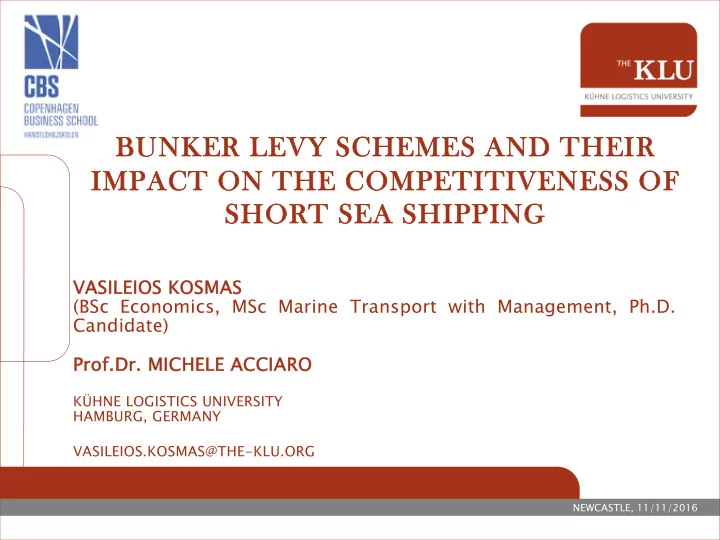

BUN BUNKER KER LEVY SC LEVY SCHEMES A EMES AND TH D THEIR EIR IMPACT ON IMPA T ON TH THE C E COMPETITIVEN OMPETITIVENESS OF ESS OF SHORT SEA SHIPPING SHORT SEA SHIPPING VASILEIOS KOSM VASILEIOS KOSMAS AS (BSc Economics, MSc Marine Transport with Management, Ph.D. Candidate) Prof rof.D .Dr. MIC . MICHELE ELE ACCIARO ACCIARO KÜHNE LOGISTICS UNIVERSITY HAMBURG, GERMANY VASILEIOS.KOSMAS@THE-KLU.ORG NEWCASTLE, 11/11/2016
RESEARCH BASED ON… 2 papers: 1) Presented at SCC2015 entitled “Bunker levy schemes for GHG emission reduction in international shipping” 2) New work 2
IONS NECESSITY NECESSIT Y FOR FOR FUR FURTHER HER EM EMISSION ISSION MIT ITIGAT IGATION ION ACT ACTIONS Inadequacy of existing measures � - Emission Control Areas (ECAs) - Energy Environmental Design Index (EEDI) - Ship Energy Efficiency Management Plan (SEEMP) Market Based Measures: the new solution? � - (Maritime) Emission Trading Scheme - Bunker Levy Scheme 3
SSS: high competitive environment ECAs= operational cost increase Bunker levy schemes = modal shift ? AIM OF THE E RES ESEA EARCH PAPER ER • Effect of this regulatory regime on the competitiveness of SSS against road transportation (modal shift). - a unit tax per ton of fuel - an ad valorem tax; as percentage of fuel prices 4
METHODOLOGY Equilibrium in shipping; interaction among the four markets � Application of the cobweb theorem to the shipping industry � Binary Choice Model � Source: Ezekiel (1938) 5
ASSUMPTIONS New order for ships at period t according to Luo et al.(2009) N t= t= n n × Π t n= average proportion of profit accounting for new vessel purchase Π = Profit , Π t = = P t W t –F –F t Ψ t P=freight rates ($/TEU), W= TEUs carried, F=fuel costs F t = ρ t f t λ t S t 3 ρ =operating time at sea (hours), f=fuel price ($/ton), λ =coefficient of ship´s energy efficiency, S= (knots) is average speed. Ψ = no of ships required, d= route distance (nautical miles) and H is ship’s average capacity (TEU) 6
Based on the cobweb theorem For the unit tax scheme Based on the cobweb theorem For the unit tax scheme: For the ad valorem scheme For the ad valorem scheme: Δ W=change in cargo transported, Δ Z=change in fleet capacity, δ >0=freight adjustment factor on the basis of demand and supply alterations, φ >0 (constant)=average fleet capacity utilization rate. 7
A DYNAMIC ECONOMIC DISCRETE CHOICE MODEL x j1 dem deman and d j1 x j2 speed xj 3 freight rates For th the unit t ta tax scenario For th the ad valorem scenario 8
Bunker levy schemes= decrease of SSS´s utility Sc Scena nario fo for ana nalysi sis s 9
AD VALOREM SCHEME Tax percentage (%) Modal shift percentage (%) Low fuel prices (300$/t) High fuel prices (600$/t) 2 0.3 0.6 5 0.7 1.4 10 1.4 2.9 15 2.2 4.3 20 2.9 5.7 30 4.3 8.6 40 5.7 11.4 10
UNIT TAX SCHEME Tax amount ($/t) Modal shift Low fuel prices (300$/t) High fuel prices (600$/t) 5 0.2 0.2 10 0.5 0.5 20 0.95 0.95 40 1.9 1.9 50 2.4 2.4 80 3.8 3.8 100 4.8 4.8 120 5.7 5.7 150 7.2 7.2 200 9.6 9.6 250 11.9 11.9 11
CONCLUSION First attempt to model modal shift from SSS to road in case of bunker levy scheme enforcement Ad valorem SSS´s Utility decrease Unit tax scheme Modal shift Policy implications: Unit tax prevents uncertainty Future steps of this research: Sensitivity analysis of variables, Effect on Social Welfare after modal shift occurrence. 12
Thank you Questions? 13
Recommend
More recommend